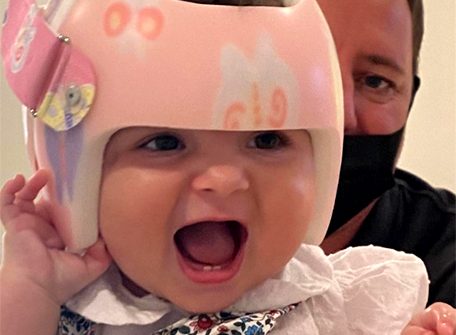Torticolis is a common condition in babies. It is usually detected by parents when they see that their child’s head is always bent to the side, and this position can be seen from the front and from behind.
Another observation that parents see is difficulty with moving the head to one side vs the other, particularly when the child is following an object with his eyes or when they are attempting to roll.
This asymmetric position of the head and neck is the result of tightening of one of the sternocleidomastoid muscles (SCM), a muscle that runs on both sides of the neck from behind the ears to the collarbone. Usually this condition can occur independently or can be comorbid with another diagnosis, and in most cases, if a good exercise , Physiotherapy & Early intervention routine is implemented, the condition can be completely resolved.
What Are The Reasons That Cause Congenital Muscular Torticollis?
Why some kids are born with muscle torticollis is unknown. Potential reasons include:
- Neck muscle tightening brought on by the pregnancy’s head position in the uterus
- The neck’s muscle development issue has resulted in a shorter-than-normal neck.
- During labor, a neck muscle was hurt.
- Congenital muscular torticollis, regardless of the source, is characterized by a short neck muscle that causes the neck to rotate to the affected side.
Symptoms Of Congenital Muscular Torticollis
- This condition’s warning signals may be present before birth. It might also go unnoticed for a few days or even weeks. Indicators include:
- The baby’s head tilted to the side of the tense muscle, and its chin turned in the opposite direction.
- A bulge on the side with the shorter neck muscle
- Reduced neck range of motion
- Due to the youngster sleeping on one side, one side of the face has become flattered.
- Your child won’t likely experience any pain because of the condition’s lack of discomfort.
Congenital Muscle Torticollis: How Is It Identified?
Often, an examination is sufficient to make the diagnosis. One or more of the imaging tests listed below may be used to confirm the diagnosis:
- X-ray to examine the neck and shoulder bones and rule out any additional issues
- Showing the neck muscles with ultrasound (sound wave pictures)
- Using MRI (magnetic resonance imaging), the neck muscles can be seen.
Are There Any Long-Term Issues?
A youngster with this illness will typically not experience any long-term issues with therapy. However, the child can end up lying on one side due to the tight muscle. This may cause the skull on that side to become flatter. This flattening is unharmful and should stop in the coming years. If you are worried that your torticollis will get worse, call your doctor.
The goal of the treatment is to recover from the muscular asymmetry, to obtain right postural control and to facilitate the correct motor development.
Consult the competent therapist at Hope AMC today. Your child will get utmost care and appropriate treatment.


